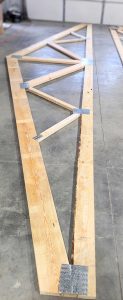Metal connector plates are used to connect wood truss members and are considered the most important invention in the light frame wood construction industry. This is due to their versatility, cost effectiveness and ease of installation. Typically composed of galvanized steel they are mainly manufactured using one of three metal thicknesses: 20, 18 and 16 gauges. The galvanization means the steel is coated with a zinc alloy for corrosion resistance. Stainless steel is also used to manufacture metal connector plates since plates are used in highly corrosive environments.
The interior pieces of a truss are webs and the continuous outside ones are the chords. Top and bottom chords typically directly carry the loads and transfer those loads to adjacent joints (the confluence of webs with the chords). The truss members can be of different sizes, grades and/or species of lumber. When constructing trusses, the members have to be in the same plane for the metal plates to connect them.
 As shown in the picture metal truss plates have integral tooth slots. Each tooth has a particular shape, size and twist design depending on the plate manufacturer. These characteristics affect the load carrying capacity of the plate. Plates with teeth on one face are placed on both faces of a truss joint and are pressed with hydraulic or roller presses to embed the teeth into different web and chord members. Once the plate connects the web and chord members, it resists the forces coming from them. All plates on a truss joint are designed to withstand forces due to tension, compression, shear, and moment.
As shown in the picture metal truss plates have integral tooth slots. Each tooth has a particular shape, size and twist design depending on the plate manufacturer. These characteristics affect the load carrying capacity of the plate. Plates with teeth on one face are placed on both faces of a truss joint and are pressed with hydraulic or roller presses to embed the teeth into different web and chord members. Once the plate connects the web and chord members, it resists the forces coming from them. All plates on a truss joint are designed to withstand forces due to tension, compression, shear, and moment.
To ensure the plates can resist the forces coming from the truss members, each plate manufacturer tests them in tension and shear at different angles. A plate’s load carrying capabilities will differ at different angles. Tension and shear values of plates are also related to the metal strength used for plates. Plates are also tested for lateral resistance or gripping, which is directly related to the lumber strength. The stronger the lumber is, the higher the lateral resistance value will be. Each manufacturer publishes the design values of their truss plates.
Just as metal connector plates to join wood truss members created a burgeoning prefabricated roof truss industry, the affordability of wide span wood trusses has revolutionized the pole building industry. This advent has allowed for clearspans of 80 and even 100 feet to become practical using wooden pole barn design.






